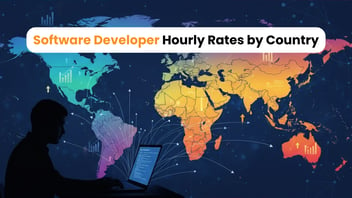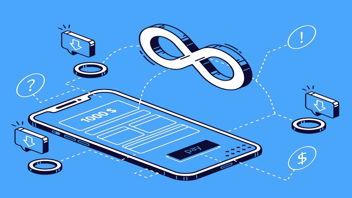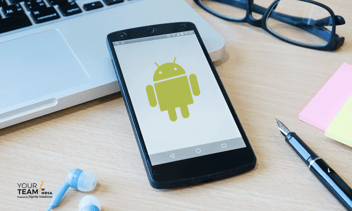Quick Summary:
Outsourcing mobile app development can be either your smartest or most expensive move. This blog provides clarity on understanding the real costs involved, the end-to-end outsourcing process, and common mistakes to avoid when outsourcing app development to India.
Key Takeaways
-
Outsourcing mobile app development can save money and provide access to skilled developers worldwide. It can also speed up development and allow for easier team expansion.
-
In the US and the UK, hourly rates are significantly higher, while countries like India offer competitive rates for talented developers. This makes India a popular choice for affordable and quality app development.
-
The cost of outsourcing mobile app development depends on how complex the app is and which platforms it targets, such as iOS, Android, or both.
In today's AI-driven era, building a smart and faster mobile app is the real edge. Every business wants to inculcate AI-powered features along with seamless UX. Moreover, it has become the need of the hour to keep pace with the mobile app market, which is projected to reach $753.34 billion by 2033.
But the real challenge is that hiring app developers takes time. On average, it takes 142 days to hire AI talent and 52 days to hire dedicated developers in technologies like Flutter, iOS, or Android.
If you're struggling to find the right talent, you're not alone. That's why more companies are turning to outsourced mobile app development in order to tap into expert skills faster and more affordably.
This blog provides a comprehensive breakdown of everything involved in mobile app outsourcing, including costs, processes, and common mistakes to avoid.
Why Choose Outsourcing for Mobile App Development?
These days, mobile app development outsourcing is more than a cost-saving tactic. It’s a strategic move to accelerate delivery, access global talent, and build feature-rich apps without the hassle of hiring in-house. With today’s demand for AI-integrated and cross-platform apps, outsourcing to India is becoming the preferred choice for businesses worldwide.
Get Access to the Top Mobile Developers
Modern businesses demand mobile app developers who are proficient in creating apps using AI, automation, and emerging technologies. This is where outsourcing helps. It connects you with skilled app developers experienced in building advanced features. Whether you need AI specialists to integrate intelligent chat or iOS and Android developers, you get instant access to the expertise you’d struggle to find locally.
Quick Development Process
Outsourcing your project can help speed up development. Since both time and speed are critical for any business owner. With outsourcing, you get access to dedicated development teams who work around the clock using agile methodologies. While your in-house development team signs off for the day, your offshore team keeps the momentum going, thus significantly cutting time-to-market.
Greater Flexibility
Outsourcing offers unmatched flexibility. You can scale your offshore mobile app development team up or down as your project evolves. Moreover, your outsourced partners adapt to your preferred development style, whether it is agile, Scrum, or DevOps, ensuring your workflow remains intact.
Cost Efficiency
One of the biggest wins? Cost efficiency. Outsourcing can save up to 70% in development costs without compromising quality. Unlike freelancers, reliable mobile app development companies offer dedicated mobile app developers, managed workflows, and accountability. Thus making IT Outsourcing a smarter long-term investment.
Breakdown of Mobile Outsourcing Costs
Budgeting for outsourced app development is crucial—it impacts every stage, from planning to launch. With outsourcing, you not only get cost advantages but also get greater predictability in estimating timelines, resources, and ROI.
You might have the following questions in your mind regarding your mobile app outsourcing -
What’s the typical cost and timeline for my type of app?
Can my outsourced team handle complex features like AI, payments, or third-party integrations?
What’s included in the outsourcing contract, and what could be extra?
Know What You'll Pay Before You Build
Use Our Free Outsourcing Calculator to Get Instant Estimates
Let’s help you break down the key factors that affect outsourced app development costs:
1. Project Complexity: MVP vs. Full-Featured App
The cost of outsourcing mobile app development services can vary significantly based on the complexity of your app.
Project complexity refers to the intricacy and richness of features in your mobile app. It directly influences development time, team size, cost, and tech stack.
For example, apps with basic functionality have low complexity and typically take 2-4 weeks, making them ideal for MVPs and early-stage startups.
On the other hand, apps with cutting-edge functionality have high complexity. It includes advanced features such as AI integrations, multi-language support, and third-party integrations. Moreover, they require larger teams and longer timelines. Thus leading to more costs.
Custom solutions tailored to your unique requirements can also increase costs.
2. Platform Choice: iOS, Android, or Cross-Platform
The platform you choose to build your app plays an important role in your outsourced app development cost.
-
iOS and Android (Native): Native development requires building separate codebases for both iOS and Android. This means higher development time and cost, but delivers the best performance and user experience.
You can hire Android developers or hire iOS developers with profound expertise in platform-specific best practices.
-
Cross-platform (Flutter, React Native): Cross-platform frameworks help you to build a single codebase that works well on both iOS and Android. It’s faster, more cost-effective, and ideal for MVPs or apps with standard UI elements.
Need flexibility and speed? Cross-platform developers help you reach both platforms at once without doubling your budget.
Pro Tip: Cross-platform apps can reduce development costs by up to 30–40%.
3. Developer Location and Hourly Rates
Your outsourcing partner's location plays an important role in your mobile application outsourcing. Here’s a look at average hourly rates by region:
|
Location |
App Development Rates |
|
USA |
$80 - $140 |
|
UK |
$45 - $65 |
|
India |
$20 - $45 |
|
South Africa |
$25 - $45 |
|
UAE |
$60 - $65 |
|
Germany |
$45 - $80 |
Insight: Many top companies consider India a top destination for IT outsourcing as it remains the most cost-efficient location without compromising on talent quality.
Below is a comparison of mobile app development costs between the US and India based on the complexity of the application.
|
Type of Application |
United States |
India |
|
Simple |
$40 - $60 |
$10 - $15 |
|
Medium |
$80 - $100 |
$20 - $30 |
|
Complex |
$120 - $125 |
$40 - $50 |
Want to compare hourly rates by country? Check out our detailed guide on Software Developer Hourly Rates by Country.
4. The Hidden Costs No One Talks About
When determining the cost of outsourcing app development, be aware of what's included and the potential hidden costs that most app development companies may not disclose.
-
Functional Costs: This includes expenses associated with fee payments for third-party integrations.
-
Infrastructure Costs: These generally encompass the costs of data delivery, storage, and application hosting. All of these contribute to the overall expenditure and intricacy of a project.
-
Management or Administrative Costs: The expenses that cover managerial and administrative aspects, such as employees' salaries and other related costs.
-
Support Charges: One cannot assume to get an application without having any IT support services. The support charges include expenses associated with additional costs to update the application, bug fixes, and making consistent improvements to the developed application.
-
Maintenance Costs: App maintenance includes the expenditures necessary to ensure ongoing accessibility, usability, and improved product performance. This can involve both regular, scheduled maintenance and ad hoc fixes.
-
Marketing Costs: This includes promoting your mobile application and increasing visibility among your target user base.
Pro Tip: Clarify your scope and post-launch needs in advance to avoid unexpected costs.
5. Type of Outsourcing
Now that you are making up your mind to outsource application development. It is vital to consider different types of outsourcing for your app development project.
IT Outsourcing offers three main models: Onshore, Nearshore, and Offshore. Each has its own set of advantages and disadvantages.
-
Onshore Outsourcing is hiring an app development team within your own country. It is similar to bringing in a team from a nearby city.
-
Nearshore Outsourcing is partnering with a team in a neighboring country or one in a similar time zone. Such teams typically work with a time difference of 1-3 hours.
-
Offshore mobile app development outsourcing involves collaborating with a team located in a different country. Offshore mobile app developers often operate in a completely different time zone. It is like hiring a dedicated team overseas.
However, the choice of the best one really depends on your project's unique needs and budget. To help you understand each one, here is a quick comparison table:
|
Feature |
Onshore Outsourcing |
Nearshore Outsourcing |
Offshore Outsourcing |
|
Location |
Within your own country |
Neighboring country/similar time zone |
Distant country/significantly different time zone |
|
Cost |
Highest (due to higher labor rates) |
Moderate (cost savings, but less than offshore) |
Lowest (significant cost savings) |
|
Communication |
Easiest (same language, culture, time zone) |
Good (similar language, culture, small time difference) |
Can be challenging (language, cultural, major time zone differences) |
|
Time Zone |
Same |
Minor difference (1-3 hours) |
Significant difference (often 8+ hours) |
|
Cultural Fit |
Very High (shared values, business practices) |
High (often similar cultural norms) |
Varies (can require more effort to align) |
|
Talent Pool |
Limited by local availability |
Larger than onshore, but smaller than offshore |
Global and vast, access to specialized skills |
|
Control |
High (easy face-to-face meetings) |
Good (easier visits, overlapping hours) |
Requires clear communication and supervision. |
Recommended Read: All You Need to Know about Nearshore vs Offshore Outsourcing
How to Outsource Mobile App Development (Step-by-Step Process)
As a founder or product owner, you already have enough on your plate. From pitch decks, user feedback, and investor updates, to now figuring out your app development process, budget and time.
We’ve been there, and we’re here to help. Here, we guide you through the outsourcing process step-by-step to help you find the right software development company and launch your project faster with confidence.
From defining your app requirements to hiring the right developers, these steps are everything you need to make smart, stress-free outsourcing decisions.
.png?width=769&height=690&name=ROADMAP%20OF%20OUTSOURCING%20YOUR%20APP%20DEVELOPMENT%20-%20visual%20selection%20(1).png)
Define your Requirements Clearly
Start with clarity. This is the golden rule when considering outsourcing app development. Outline what kind of mobile app you want to build, your core features, platform preferences (iOS, Android, or both), and whether you're hiring dedicated developers or a full development team.
The clearer your project requirements, the easier it will be to communicate your goals to your outsourcing mobile app development partner.
Go Through the Options Thoroughly
Once you have clearly defined the requirements, do the market research. Prepare a list of top mobile app development companies based on your preferred outsourcing model (onshore, nearshore, or offshore). Shortlist your software development agency by evaluating:
-
Project case studies and portfolios
-
Technical stack and platform expertise
-
Client testimonials and reviews
-
Proven track record with similar industries or app types
Additionally, evaluate whether they have qualified project managers to handle complex workflows and what kind of remote project management practices they follow.
Select the Engagement Model
The next step is to determine which model fits your budget, allowing you to manage the outsourced mobile app development cost and project scope effectively. You can opt for either of these models while choosing your outsourcing partner:
-
Dedicated Team: Best for long-term or evolving projects.
-
Fixed Price Model: Ideal for a well-defined scope and budget.
-
Outstaffing: Hire specific roles (e.g., Android developer, UI/UX expert) without building an entire team.
Pro Tip: You can explore hybrid or cross-platform app development, which can help in cutting your costs to outsource while offering wider platform coverage.
Evaluate Developer Profiles
Once you've shortlisted potential app development outsourcing companies, it’s time to dive into the developer profiles. Ask your outsourcing partners to share detailed CVs and portfolios of the developers who could join your development team. Carefully assess their:
-
Technical skills and coding proficiency
-
Experience with similar mobile apps or industries
-
Familiarity with your preferred tech stack
-
Problem-solving and communication abilities
You're not just outsourcing a task; you're building a mobile app outsourcing partnership. Make sure your outsourcing team aligns with your business goals and can deliver real results.
Tip: Don’t hesitate to run a short technical assessment. It’s a quick way to verify capabilities before onboarding.
Want more guidance? Check out our blog on 10 Factors to Consider While Hiring a Mobile App Developer to make smarter hiring decisions.
Onboard Developers
Once you've chosen your app development outsourcing company, it’s time to move from planning to execution. But before you dive into sprints, don’t skip the onboarding phase—especially when you outsource app development.
A smooth onboarding process ensures your outsourced app development team is aligned with your in-house goals, understands the product vision, and is clear on communication protocols, tools, and timelines. This step is crucial for agile execution, sprint success, and preventing miscommunication in the future.
Whether you’re working with one developer or a full-stack team, proper onboarding lays the foundation for a productive and collaborative development cycle.
Need help navigating the hiring journey?
Our comprehensive guide on how to find app developers can help you identify the right team faster.
Common Mistakes to Avoid While Outsourcing Mobile App Development
Outsourcing your mobile app development can lead to quicker delivery, access to top talent, and significant cost savings, but only if done correctly. Yet, a staggering 70% of IT projects face serious budget overruns or fail to achieve their original goals.
These aren't just statistics; they represent real risks.
Poor communication, unrealistic expectations, choosing the wrong outsourcing partner, or underestimating costs can affect your mobile app outsourcing.
Whether you're new to outsourcing or looking to improve your strategy, below are some of the common mistakes to avoid the hassle and discover how high-performing teams stay on schedule and within budget.
1. Poorly Defined Requirements
If you fail to communicate clear, detailed briefs, it leads to confusion, missed deadlines, and guesswork for the development team.
Solution: Use diagrams, sketches, and clear workflows to ensure alignment with your outsourcing team.
2. Prioritizing Cost Over Quality
Choosing cheap outsourcing companies may seem smart, but it often results in low-quality code, technical debt, and higher maintenance costs.
Solution: Always prioritize value, expertise, and long-term ROI by choosing a reliable partner to manage your outsourced app development costs.
3. Neglecting Project Management
One of the most common mistakes is assuming your remote team will manage everything. While outsourcing partners are often highly capable, they still need direction, accountability, and alignment with your business goals.
Solution: Hire a project manager who understands your project requirements. Set clear milestones, hold regular meetings, and closely monitor their progress to ensure timely completion.
4. Ignoring Security & IP Protection
One of the most overlooked risks in mobile application outsourcing is failing to prioritize security and intellectual property (IP) protection. Your sensitive data, source code, and proprietary ideas are potentially exposed to misuse or theft if not properly secured.
Solution: Always sign NDAs and IP transfer agreements. Confirm about security protocols, cloud storage policies, and compliance certifications before you outsource app.
5. Validating App Idea with Complete Development
Jumping straight to full development without prototyping can result in UX mismatches. When planning to outsource mobile app development, ensure to validate your idea by developing an MVP for the application.
Solution: Collaborate with a reliable MVP app development company that prioritizes the development process with all the necessary features. They can validate the your idea quickly with apt features and functionalities.
ROI: How to Measure the Success of Your Outsourced Mobile App Development
When outsourcing app development, define key performance indicators (KPIs) to gauge success. We have categorized these KPIs into three groups. The following section outlines the essential KPIs for assessing the success of mobile application development outsourcing:
1. Development-Focused KPIs
Development-focused KPIs measure how efficiently and effectively an app is developed. Here are the main KPIs you need to consider if you outsource app development.
-
On-Time Delivery
To reduce delays and ensure a smooth development process, measure your app development timeline accurately. This helps you ensure that milestones are met on time.
-
Staying within Budget
Track whether the project stays within its budget. Cost overruns can negatively impact the overall ROI. So, it is important to monitor expenses closely.
-
Code Quality
Evaluate the quality of the codebase. You can check its scalability, maintainability, and the number of defects. A good code quality helps avoid extra work and ensures the app runs smoothly.
2. User-Focused KPIs
User-focused KPIs measure how well the app meets the user's expectations. These KPIs tell about how well the app is accepted in the market.
-
App Downloads
Tracking app downloads shows the app's popularity. In its early stages, monitoring app downloads is crucial to understanding whether your target audience accepts it or not.
-
User Engagement
Track how actively users interact with the app. This can include metrics such as session length, frequency of use, and feature utilization.
-
User Retention
This shows how well the app retains users over time. High retention rates indicate that the app continues to provide value to its users.
Business-Focused KPIs
Business-focused KPIs help connect app performance to the company's overall goals. They measure the financial and strategic impact of the app.
-
Revenue Generated
This tracks the direct income generated by the app, including in-app purchases and subscriptions.
-
Customer Acquisition Cost
This measures the cost of acquiring each new user. Lower costs mean better marketing and user acquisition.
-
Customer Lifetime Value
This estimates the total revenue a customer is expected to generate during their time using the app. A high value suggests the business can sustain itself over the long term.
Customer Success Stories
Nothing demonstrates the power of smart IT outsourcing better than a success story. That is why we have brought a real-life success story that has benefited from IT outsourcing.
At Your Team In India, we have had the privilege of working with numerous clients across the US, Western Europe, and other parts of the world. We are proud to be a reliable source for them to leverage the incredible talent pool in India.
Our experience consistently demonstrates that, with the right partner, geographical distance is no barrier to developing high-quality mobile applications.
A great example of how a South African client successfully outsourced a complex mobile app project to an Indian team is our work on a Rideshare Carpooling App.
Our client is a Southern African company with a great idea for a rideshare and carpooling app. They aimed to develop a solution that is easy to use, secure, and connects passengers with drivers traveling in the same direction.
The client chose us as their app development agency to create a custom mobile application for their business needs. Our team in India collaborated closely with them to understand every detail of the app's requirements.
We assigned a dedicated outsourcing team that collaborated with their in-house team and our business development manager. The outsourcing development team consisted of -
-
Mobile developers (Both iOS and Android)
-
UI/UX designers
-
DevOps Engineer
-
Backend engineers
-
Project Manager
-
QA specialists.
The outcome was a strong and feature-rich rideshare carpooling app that went beyond the client expectations. The app launched successfully, providing a seamless experience for both drivers and riders.
This is just one successful mobile application outsourcing example of how Your Team In India (YTII) partners with businesses globally to turn their ambitious ideas into successfully running apps.
Want to dive deeper into this success story? You can read the full case study here: Rideshare Carpooling App Development Solution.
Conclusion
Outsourcing mobile development can efficiently and cost-effectively bring your ideas to life. By understanding different outsourcing models and managing the process well, you can avoid mistakes and measure your ROI effectively. This will help you achieve a successful outcome.
If you are juggling to outsource mobile application development and want to tap into top talent, save on costs, and streamline development, working with a reliable IT outsourcing firm is a smart choice. Your Team In India (YTII) is here to help you create outstanding mobile apps and reach your business goals.
Want to validate your mobile app development idea?
Get your app developed by a team of dedicated developers proficient in trending and advanced technologies like Flutter, AI and more.
FAQs
The cost to hire a mobile app developer can range anywhere between $16-$30/hr in India, whereas $30-$60/hr in the U.S. The cost varies according to the mobile app developer's expertise, skills and location as well.
Outsourcing generally costs less than hiring an in-house team.
-
For a basic app, it might be around $6,000 to $45,000.
-
For a medium app, $55,000 to $110,000.
-
For a complex one, it can range from $110,000 to over $260,000.
However, the cost may vary based on several factors like app complexity and technologies used.
Outsourcing for an MVP (Minimum Viable Product) helps you test your new app idea quickly and affordably. You get access to expert outsourcing developers, save money by not hiring a full team, and can get feedback from real users quickly.
Firstly, define what your app needs to do. Next, find a trustworthy outsourcing partner, such as YTII, that has a proven track record of success. Work with them to outsource mobile developers or choose the right team and tools for communication, such as video calls or PM software, to stay connected. Set clear goals and have regular check-ins.
- Hiring Certified and Experienced Developers
- Client’s Team Management
- Offering State-of-Art-Infrastructure in terms of Hardware and Software
Many US and UK companies hire developers from Eastern Europe, such as Poland and Ukraine, and Asia, including India and the Philippines. India is particularly popular due to its large number of skilled developers who speak English and offer cost-effective services. This makes India a top destination to outsource app development.
- Hiring Certified and Experienced Developers
- Client’s Team Management
- Offering State-of-Art-Infrastructure in terms of Hardware and Software
You can outsource app development when there is a lack of the tech skills needed in your in-house team, you need to develop the app faster, and you want to reduce development costs.
- Hiring Certified and Experienced Developers
- Client’s Team Management
- Offering State-of-Art-Infrastructure in terms of Hardware and Software
The cost of a custom mobile app can vary a lot:
-
Simple apps with basic features cost $10,000 - $50,000
-
Medium apps with more features, and some integrations cost $50,000 - $120,000
-
Complex apps with advanced features, AI, real-time functions, and complex integrations costs around $150,000 - $300,000+
These costs depend on how complex the app is, its design, the number of features, whether you want an iOS or Android app and your outsourcing location.
When searching for the best outsourcing company for mobile app development, look for a company with:
-
Proven Experience: Review their past projects and case studies, particularly those related to apps similar to yours.
-
Good Reviews: Look at client testimonials and ratings on sites like Clutch or GoodFirms.
-
Strong Communication: Ensure they have clear communication processes and English proficiency.
-
Technical Expertise: Do they have the skills for the specific technologies your app needs?
-
Transparent Pricing: Make sure their quotes are detailed and clear, with no hidden costs. They should offer both hourly as well as fixed price.







